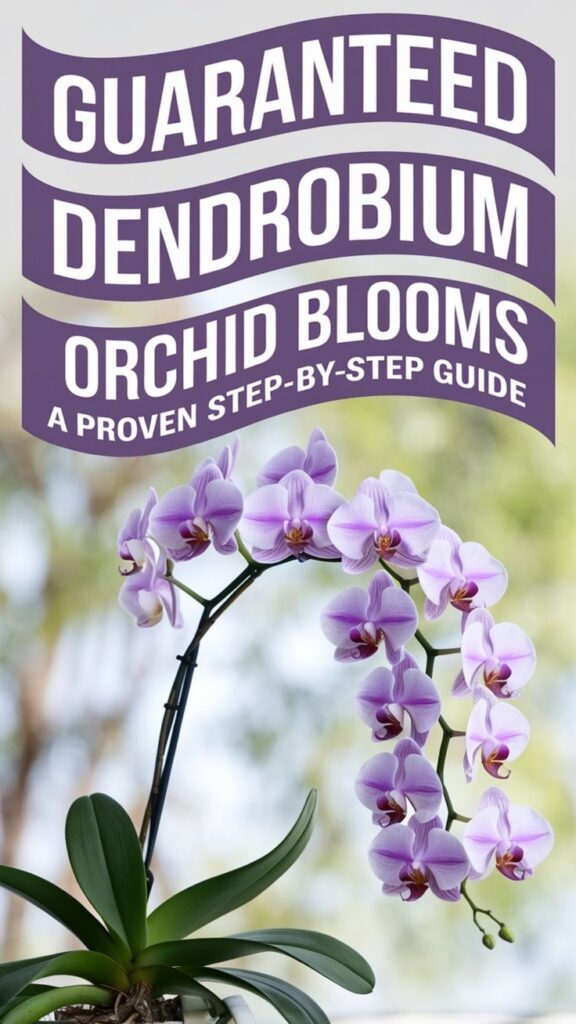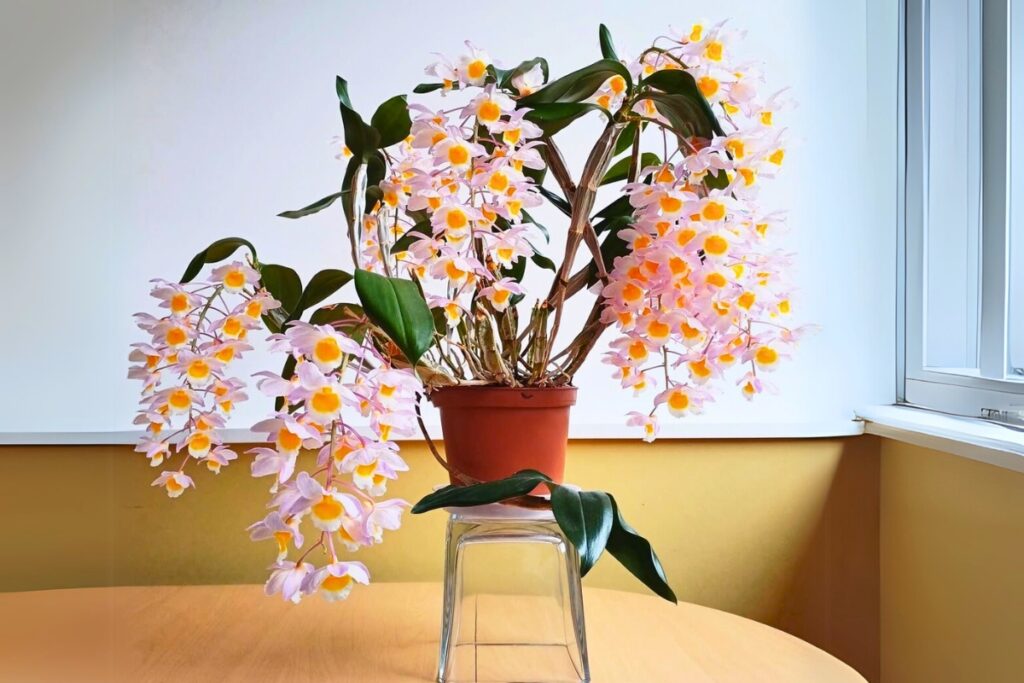While many believe that getting Dendrobium orchids to rebloom is a matter of luck, there’s actually a precise science behind it. You’ll need to create specific conditions that mimic their natural habitat’s seasonal changes, including temperature drops and adjusted light exposure. If you’ve struggled with coaxing new blooms from your Dendrobium, you’re not alone – but understanding the key environmental triggers will transform your success rate with these stunning tropical plants.

Contents
- 1 Understanding Dendrobium Orchid Growth Cycles
- 2 Essential Light Requirements for Reblooming
- 3 Temperature and Humidity Control
- 4 Proper Watering and Fertilizing Techniques
- 5 Triggering the Rest Period
- 6 Pruning and Maintenance Tips
- 7 Common Reblooming Problems and Solutions
- 8 Seasonal Care Guidelines for Year-Round Blooms
Understanding Dendrobium Orchid Growth Cycles
Before you can successfully coax your Dendrobium orchid to rebloom, you’ll need to understand its natural growth cycle. These orchids follow a predictable pattern of active growth during spring and summer, followed by a significant rest period in fall and winter.
During the active phase, your orchid will produce new stems, leaves, and roots when temperatures range between 65-85°F. You’ll notice the most vigorous growth in late spring, with pseudobulbs developing into mature canes.
The dormancy period typically begins when temperatures drop below 60°F, triggering the plant to stop growing and conserve energy for future blooming cycles.

Essential Light Requirements for Reblooming
While Dendrobium orchids can tolerate varying light conditions, they’ll need bright, indirect sunlight for 5-6 hours daily to trigger reblooming. Place your orchid 3-4 feet from an east or south-facing window, where it’ll receive filtered morning light but avoid harsh afternoon rays.
You’ll know your orchid’s getting proper light when its leaves appear bright green. If they’re dark green, move the plant closer to the window. Yellow or reddish leaves indicate too much sun exposure, so adjust accordingly. During winter months, you might need to supplement with grow lights positioned 12-18 inches above the plant for 14-16 hours daily.
Temperature and Humidity Control
Your Dendrobium orchid’s reblooming success depends heavily on temperature fluctuations, with ideal daytime temperatures between 75-85°F dropping to 60-65°F at night. You’ll need to maintain humidity levels between 50-70% by using humidity trays, grouping plants together, or running a small humidifier nearby. To trigger blooming, you’ll want to adjust these conditions seasonally, especially during the critical winter rest period when temperatures should drop about 10 degrees lower than usual.
Day-Night Temperature Variations
To successfully trigger reblooming in Dendrobium orchids, maintaining proper temperature fluctuations between day and night is essential. You’ll want to guarantee daytime temperatures reach 75-85°F (24-29°C), while nighttime temperatures should drop 15-20 degrees lower.
During fall and winter months, you’ll need to create more dramatic temperature shifts. Let your orchids experience nighttime temps between 55-60°F (13-16°C), as this cooling period mimics their natural habitat and stimulates flower spike development.
Don’t forget to maintain these temperature variations for at least 3-4 weeks. If you’re growing indoors, you can achieve these fluctuations by adjusting your thermostat or moving plants closer to cool windows at night.
Maintaining Proper Humidity Levels
Maintaining proper humidity stands as one of the most critical factors for reblooming Dendrobium orchids. You’ll want to keep humidity levels between 50-70% during the growing season, while slightly reducing it to 45-60% during the rest period.
To achieve these levels, place your orchid on a humidity tray filled with pebbles and water, making sure the pot doesn’t sit directly in the water. You can also use a humidifier or group several plants together to create a microclimate.
Monitor humidity levels with a hygrometer, and mist your orchid‘s leaves in the morning if you’re in a dry climate. Just don’t mist the flowers, as this can cause spotting.
Seasonal Temperature Adjustments
Because Dendrobium orchids thrive with distinct seasonal changes, temperature adjustments play an essential role in triggering their blooming cycle. You’ll need to mimic their natural environment by providing warmer days (75-85°F) and cooler nights (60-65°F) during their growing season.
In fall and winter, reduce temperatures by 10-15 degrees to signal the blooming phase. Keep daytime temperatures between 65-75°F and nighttime temperatures between 50-55°F. Don’t let them drop below 50°F, as this can damage your orchids.
If you’re growing indoors, you can achieve these temperature variations by adjusting your thermostat or moving plants closer to windows during winter months.
Proper Watering and Fertilizing Techniques
When your Dendrobium orchid thrives, proper watering and fertilizing techniques become essential factors in encouraging reblooming. Water thoroughly when the potting medium feels dry to the touch, usually every 5-7 days during growing season. Let excess water drain completely to prevent root rot.
Feed your orchid with a balanced 20-20-20 fertilizer, diluted to quarter strength, every two weeks during active growth. During the winter rest period, reduce fertilizing to once monthly. You’ll want to flush the potting medium with plain water monthly to prevent salt buildup.
Always water in the morning, and avoid getting water on the leaves or crown.
Triggering the Rest Period
To trigger your dendrobium orchid’s essential rest period, you’ll need to gradually reduce both watering and fertilizing as temperatures begin to cool. During this time, you should lower nighttime temperatures to between 55-60°F (13-16°C), which mimics the orchid’s natural winter conditions. Your orchid will respond to these environmental changes by entering dormancy, which is vital for developing future bloom spikes.
Reduce Water and Fertilizer
After your Dendrobium orchid has finished blooming, you’ll need to trigger its essential rest period by gradually reducing water and fertilizer. Cut watering frequency to once every 10-14 days, and stop fertilizing completely during this phase.
During winter months, maintain this reduced watering schedule, but only water when the potting medium feels completely dry to the touch. Insert your finger about an inch deep into the substrate to check moisture levels. If you’re unsure, it’s better to underwater than overwater during dormancy.
This reduction in resources signals to your orchid that it’s time to rest and prepare for its next blooming cycle.
Lower Nighttime Temperatures
Since cooling temperatures naturally signal dormancy in Dendrobium orchids, you’ll need to provide nighttime temperatures between 55-60°F (13-16°C) for at least 4-6 weeks. You can achieve this by moving your orchid to a cooler room, placing it near a window during winter months, or setting up a small fan to circulate cool air.
During this cooling period, maintain warmer daytime temperatures around 70-75°F (21-24°C). This day-to-night temperature difference, known as diurnal variation, is essential for triggering your orchid’s blooming cycle. If you’re growing indoors, consider moving your plant to an unheated sunroom or enclosed porch at night.
Pruning and Maintenance Tips
When your Dendrobium orchid’s blooms have naturally faded, proper pruning becomes essential for promoting future flowering cycles. Cut the flower spike 1/2 inch above the node where it emerged, using sterilized pruning shears to prevent infection.
Remove any yellowed or withered leaves, and trim dead aerial roots while leaving healthy green ones intact. Don’t cut into the canes unless they’re completely dried and brown, as they store nutrients for future growth.
Wipe your cutting tools with 70% isopropyl alcohol between each cut. For maintenance, dust the leaves monthly with a damp cloth, and remove debris from the potting medium to prevent pest problems.
Common Reblooming Problems and Solutions
Even with proper pruning and maintenance, Dendrobium orchids can face several obstacles that prevent reblooming. If your orchid isn’t flowering, check for insufficient light exposure, which often results in dark green leaves instead of the lighter, yellowish-green color you’re aiming for.
Temperature fluctuations can also disrupt blooming cycles. You’ll need nighttime temperatures between 55-65°F for at least four weeks to trigger flower spikes. If temperatures remain too warm, your orchid won’t receive the necessary cooling period.
Overfeeding is another common culprit. If you’re applying fertilizer more than twice monthly during growing season, you’re likely promoting leaf growth at the expense of flowers.
Seasonal Care Guidelines for Year-Round Blooms
To achieve year-round blooms from your Dendrobium orchid, you’ll need to adjust your care routine with each season’s unique requirements.
In spring, gradually increase watering and fertilizing as new growth emerges. Maintain temperatures between 65-80°F, and position your orchid in bright, indirect light for 12-14 hours daily.
Summer calls for maximum light exposure, regular feeding every two weeks, and increased humidity through misting. During fall, reduce watering by 30% and switch to a low-nitrogen fertilizer to promote blooming.
Winter requires a rest period with minimal watering, cooler temperatures (55-65°F), and no fertilizer for 6-8 weeks. This cooling period triggers the next blooming cycle.
